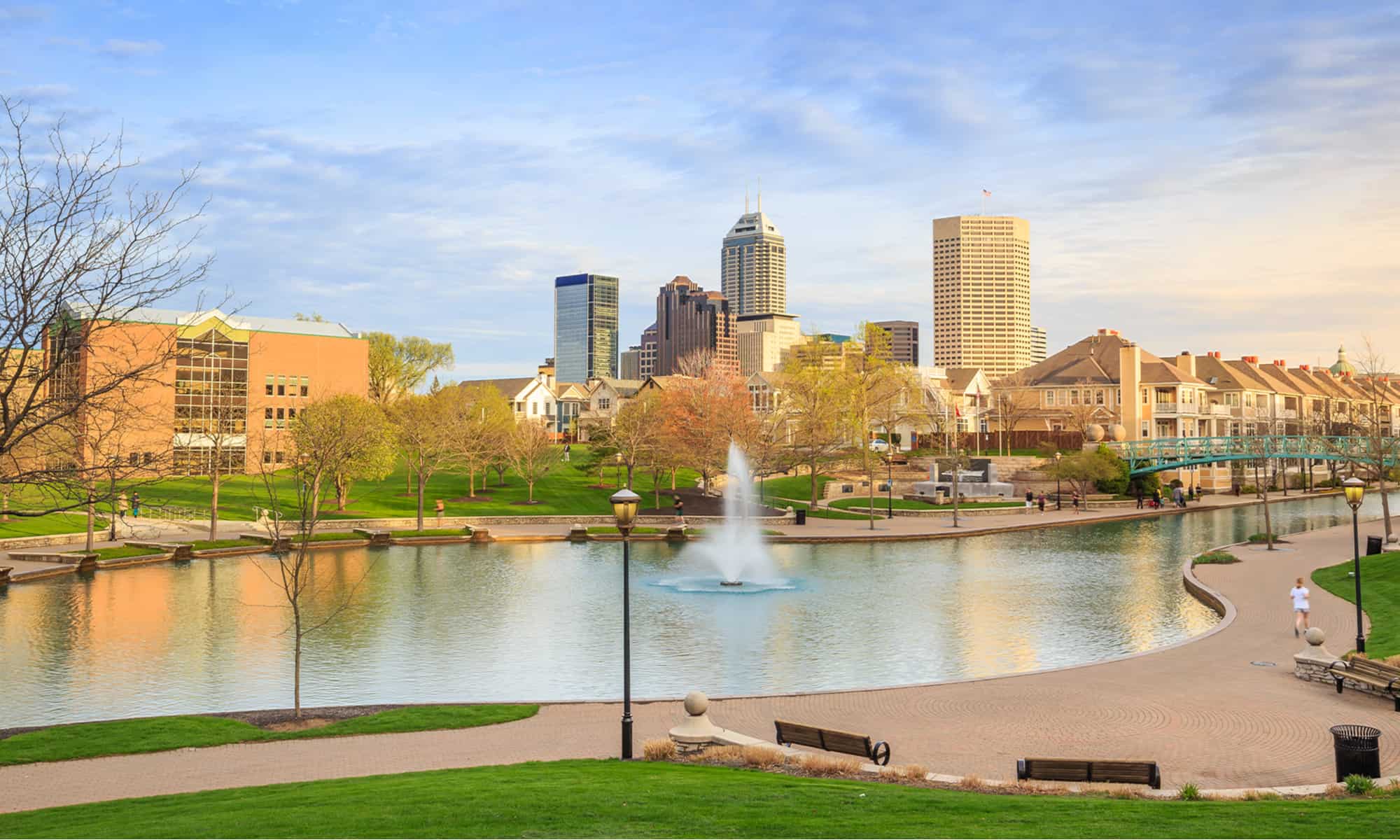When thinking of Indiana, images of cornfields and small towns come to mind. While large portions of the state are covered in fields and modest communities, Indiana has much more to offer. Beautiful landscapes abound, including lakeshore beaches, forests, and rolling hills. And its historic cities were thriving Native American communities long before the first Europeans set foot in the state. In this article, we look at several of the oldest cities in Indiana. We detail their unique contributions to the state’s past and present.
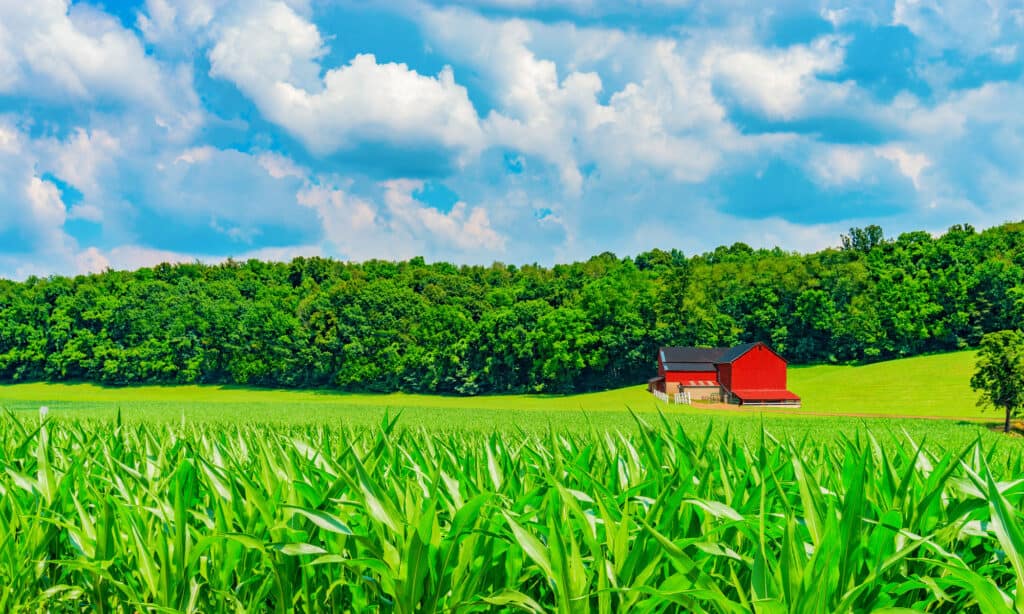
Indiana is known for its corn and rural charm, but there’s a whole lot more to the state, including thriving urban centers.
©Patricia Elaine Thomas/Shutterstock.com
Oh, and by the way, definitions of “city” vary widely. We’ve chosen to include just places with a population of at least 1,500 people as of the 2020 census. Ghost towns are exempt from this list. You’ll only find friendly places ready to welcome you on your next vacation.

Environment of Indiana
Located in the Midwestern United States, Indiana has a humid continental climate. This means it gets a good dose of all four seasons. Indiana experiences hot, humid summers, cold snowy winters, and a mild fall and spring with turbulent weather. However, of the estimated 1,200 tornadoes that hit the U.S. every year, only about 22 occur in Indiana. Indiana gets plenty of precipitation, which is generally spread evenly through the year, so it’s an ideal place for agriculture.
Indiana has plenty of wild spaces as well. It has forests of oak, maple, beech, and hickory. Hunting is popular in the state and there are plenty of white-tailed deer and wild turkeys. The major carnivores that occasionally turn up include black bears, bobcats, and coyotes. Fishermen catch bluegill, bass, catfish, and many other species, both indigenous and artificially stocked. Indiana has managed to achieve a balance between economic development and the preservation of wild spaces. This balance makes its towns and cities quite livable — so much so that nearly seven million people call it home.
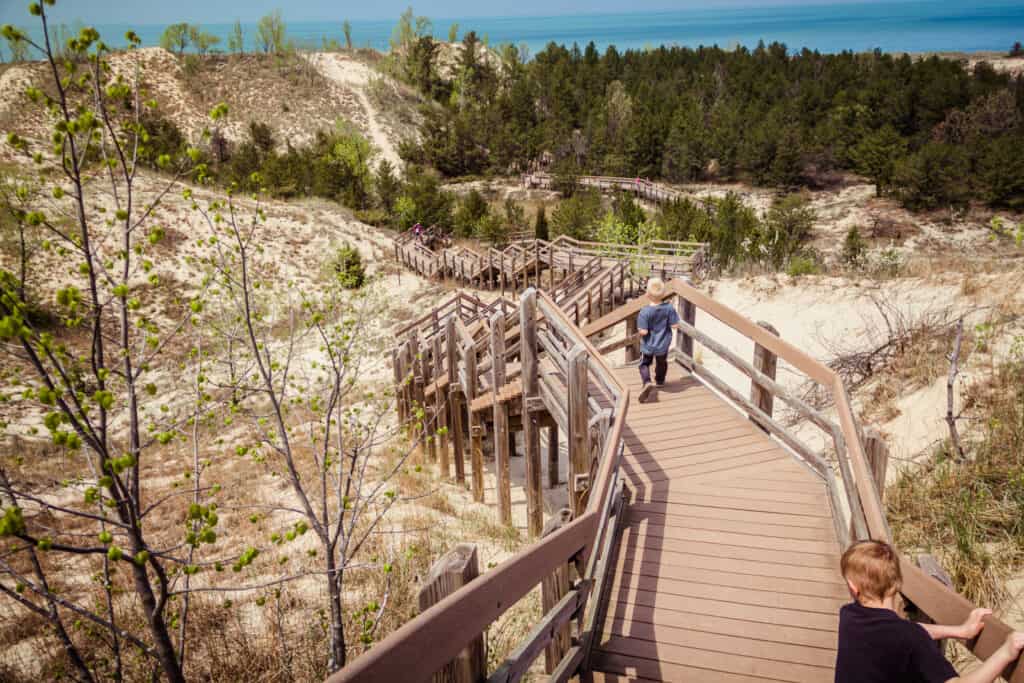
Indiana’s natural environment is more diverse than you may expect, such as sand in the Indiana Dunes State Park.
©Jon Lauriat/Shutterstock.com
1. Vincennes, 1732
The Shawnee, Wabash, and Miami tribes inhabited the area of Vincennes for hundreds of years. That is, until French fur trader Francois Vincennes arrived and built a fort and fur trading post there in 1732. It is the oldest continuously inhabited European community in Indiana and became the territorial capital. Today 16,759 people live in Vincennes.
If you visit, you might be interested in the George Rogers Clark National Historical Park. This famous park has a monument honoring a Revolutionary War hero. History lovers might also be interested in Grouseland, the home of William Henry Harrison, the 9th U.S. president. He died after just 31 days in office. Also don’t forget the Indiana Military Museum that memorializes our country’s veterans. The historic Pantheon Theatre has been around since silent movie days when an organist performed live. Finally, there’s the Red Skelton Museum of American Comedy for those who remember this remarkable entertainer. You can see some of his personal memorabilia, professional items, and artwork he produced.
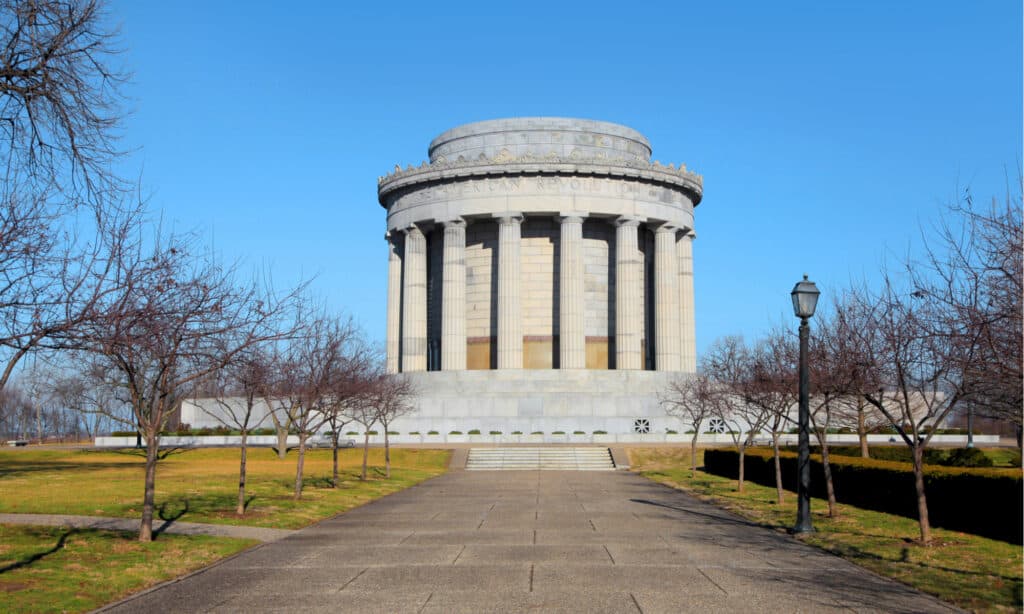
The George Rogers Clark National Historical Park in Vincennes features this impressive monument.
©SNEHIT PHOTO/Shutterstock.com
2. Clarksville, 1783
Clarksville was founded in 1783 by Revolutionary War hero George Rogers Clark. This area was his headquarters as commander of the Illinois Regiment. After the war he was awarded 150,000 acres of land for his service, 1,000 acres of which he set aside to develop the town of Clarksville. The city is located on the Ohio River, directly across from Louisville, Kentucky. It has historically had problems with flooding due to its location. In recent years it has worked together with the community of Jeffersonville to coordinate the construction of an additional pumping station to reduce water levels in areas that are built on the Ohio River floodplain.
Clarksville has several tourist attractions of interest. The Falls of the Ohio State Park have large areas of exposed fossil beds. Lapping Park is available for all sorts of outdoor activities, like softball, volleyball, basketball, tennis, golf, hiking, and has playgrounds for children. There is also an outdoor amphitheater. The Derby Dinner Theater combines fine dining with professional live theater. It’s the only thing of its sort in the regions of southern Indiana and Louisville, Kentucky. And if you have time, you can see just how much time you have by checking out one of the 10 largest clocks in the world, located near the river.
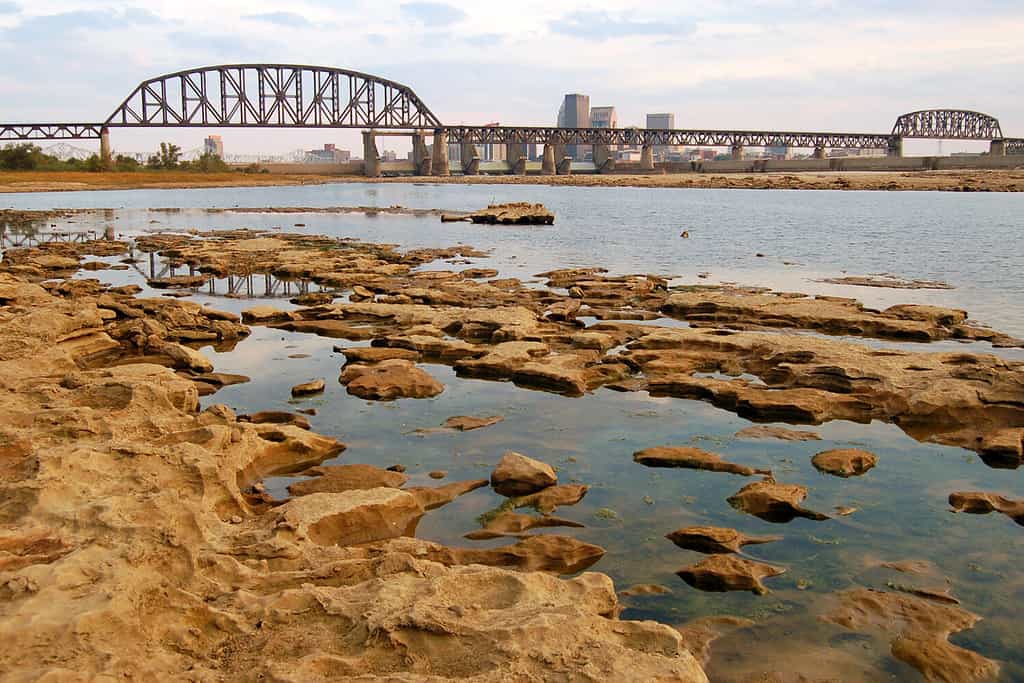
In the river bed at the Falls of the Ohio State Park visitors can see exposed Devonian Period fossils.
©James Kirkikis/Shutterstock.com
3. Jeffersonville, 1786
Jeffersonville is located directly across the Ohio River to the north of Louisville, Kentucky. This strategic location has shaped the city’s fortunes since it was first founded in 1786 as a military outpost to monitor the river for attacks by unfriendly indigenous tribes. As this became less and less of a threat, the city became a center for shipbuilding and later the “Jeffboat” company won contracts from the U.S. Navy. Jeffersonville’s location also turned it into the main station of the Underground Railroad for slaves escaping from captivity in Kentucky and other southern states to freedom in the North. After the Great Depression, Jeffersonville reinvented itself again, this time as a gambling center that earned it the nickname “Little Las Vegas.” Today nearly 50,000 people call this still-thriving city home.
Jeffersonville was the birthplace of Papa John’s Pizza, so you’ll find plenty of pizza there as well as all sorts of other dining and shopping options, antique shops, spas, bars, and clubs. Outdoors, the city has hiking trails, caverns, golf courses, farmers’ markets, parks, playgrounds, and green spaces. The Big Four Station is a park at the entrance of the Big Four Bridge. Each year the Abbey Road on the River festival is held there to celebrate the music of the Beatles and other classic rock. The Jeffersonville Riverfront is also a perfect place to watch Thunder Over Louisville, an enormous airshow and fireworks display in Louisville that kicks off the Kentucky Derby Festival every year in April.
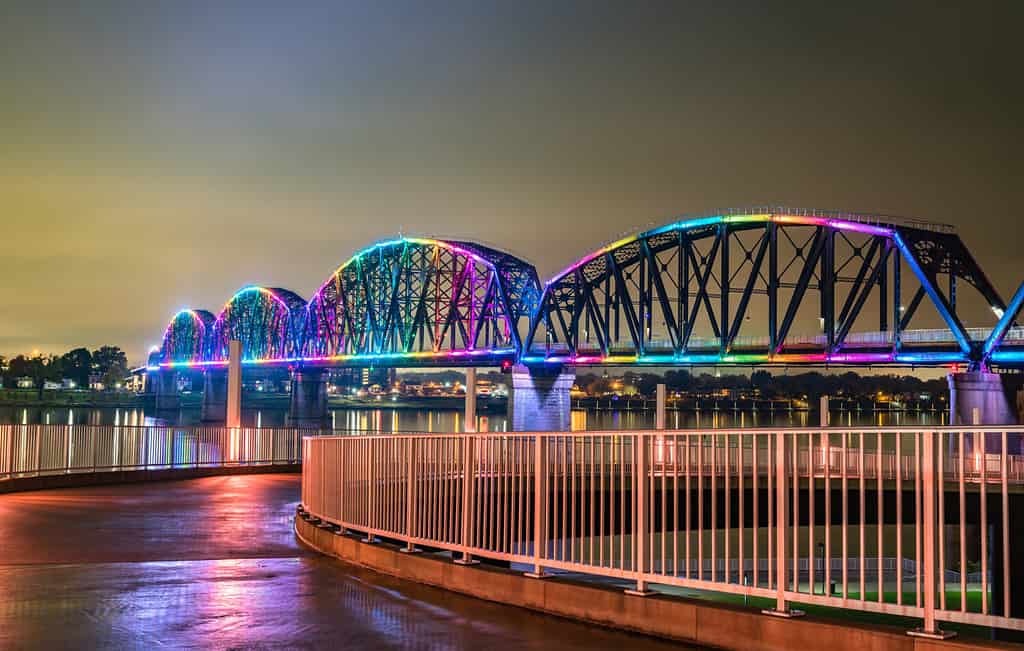
The Big Four Bridge links Jeffersonville, IN to Louisville, KY.
©Leonid Andronov/Shutterstock.com
4. Fort Wayne, 1794
Fort Wayne has a population of 264,000 and is the second-largest city in Indiana after Indianapolis. Like many other of the oldest cities in Indiana, it was built as a military outpost to protect settlers from indigenous tribes and to act as a trading outpost for the area. One of the reasons Fort Wayne so outgrew the others is that it sits at the place where three rivers meet: St. Joseph, the St. Mary’s, and the Maumee River. Before modern roads and vehicles, rivers were the cheapest, fastest, and easiest way for farmers to get their produce to market.
The city really started to swell in size during the European immigration wave of the early part of the 20th century, when large numbers of German and Irish immigrants settled in the area. Now, in the 21st century, Fort Wayne has a diverse economic base that relies not only on transportation, distribution, and logistics, but healthcare, professional and business services, financial services, entertainment, and support services for the military.
If you want to sample Fort Wayne yourself, there’s a ton to do and see. Here are just a few suggestions:
- Historic Fort Wayne and historical reenactments
- A children’s zoo and Science Central (an interactive science educational center)
- River activities: camping, fishing, boating, watersports of all kinds
- Parks, marathons, skate parks, a trampoline park, escape rooms
- Professional and intercollegiate sports
- Germanfest, the Greek Festival, the Japanese Cherry Blossom Festival, and others.
- At the Embassy Theater see Broadway shows and other entertainment and view the city from the rooftop.
- The Johnny Appleseed Festival, drawing 300,000 people to celebrate this celebrated tree-planter, believed to be buried at Johnny Appleseed Park.
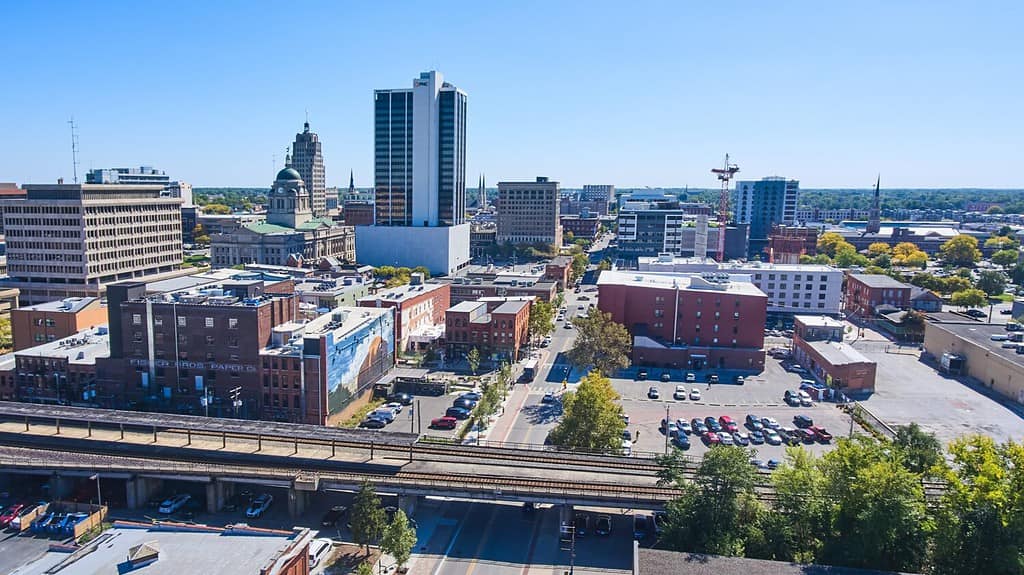
Fort Wayne is the second-largest city in Indiana.
©Nicholas J Klein/Shutterstock.com
5. Corydon, 1808
Established in 1808, Corydon is the spring chicken on our list of the oldest cities in Indiana. Like some of the others, it is in southern Indiana not far from Louisville. It began to be settled earlier, but due to conflict with Native Americans in the area, earlier settlement efforts were abandoned until after the Indiana Territory was officially organized. A notable event in 1814 was when Paul and Susannah Mitchem moved to the area along with 100 slaves, who they freed there. Many of them settled permanently in the area. During the Civil War, Corydon was captured by Confederates during “Morgan’s Raid” and robbed. Each shop owner had to pay a ransom to prevent his business from being burned to the ground.
These days, Corydon and its southern neighbors are getting along a lot better. But you can still learn about those troubled earlier days at Morgan’s Raid / Battle of Corydon Battlefield, where the battle is reenacted every year, and in the Corydon Historic District, which is listed in the National Register of Historic Places. The city has a population of 3,153 and hosts annual county fairs, parades, band concerts that give an authentic taste of Middle America. The area also has caverns, nature preserves, and hiking trails for outdoorsmen and women, and vineyards, antique shops, specialty gift and book shops, restaurants, and dessert shops for folks who prefer the great indoors.
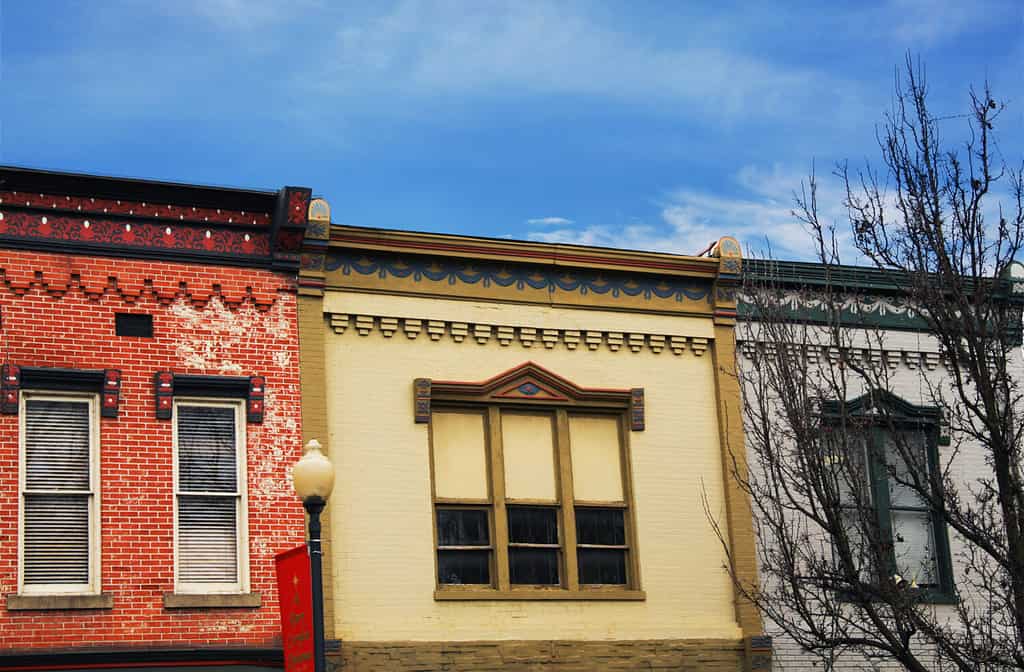
There is plenty of vintage architecture in Corydon, Indiana.
©Melinda Fawver/Shutterstock.com
Ready to Raid Indiana?
In different ways, the oldest cities of Indiana remind us of not only the triumphs of the building of the country, but the great human costs to indigenous people, the settlers, and the soldiers who struggled over the land. We can honor them by remembering, learning, and not taking for granted what we have today. And there is so much to be grateful for in Indiana: an ideal climate, a thriving natural environment, healthy business opportunities, and friendly communities that are a great place to settle down and raise a family. Even if you don’t plan to live there, why not plan your own “raid” on Indiana for your next vacation, and see what treasures you find there?
Summary of 5 of the Oldest Cities in Indiana
Here’s a recap of five of Indiana’s oldest cities that we took a close look at.
| Rank | City | Date Founded |
|---|---|---|
| 1 | Vincennes | 1732 |
| 2 | Clarksville | 1783 |
| 3 | Jeffersonville | 1786 |
| 4 | Fort Wayne | 1794 |
| 5 | Corydon | 1808 |
Thank you for reading! Have some feedback for us? Contact the AZ Animals editorial team.

